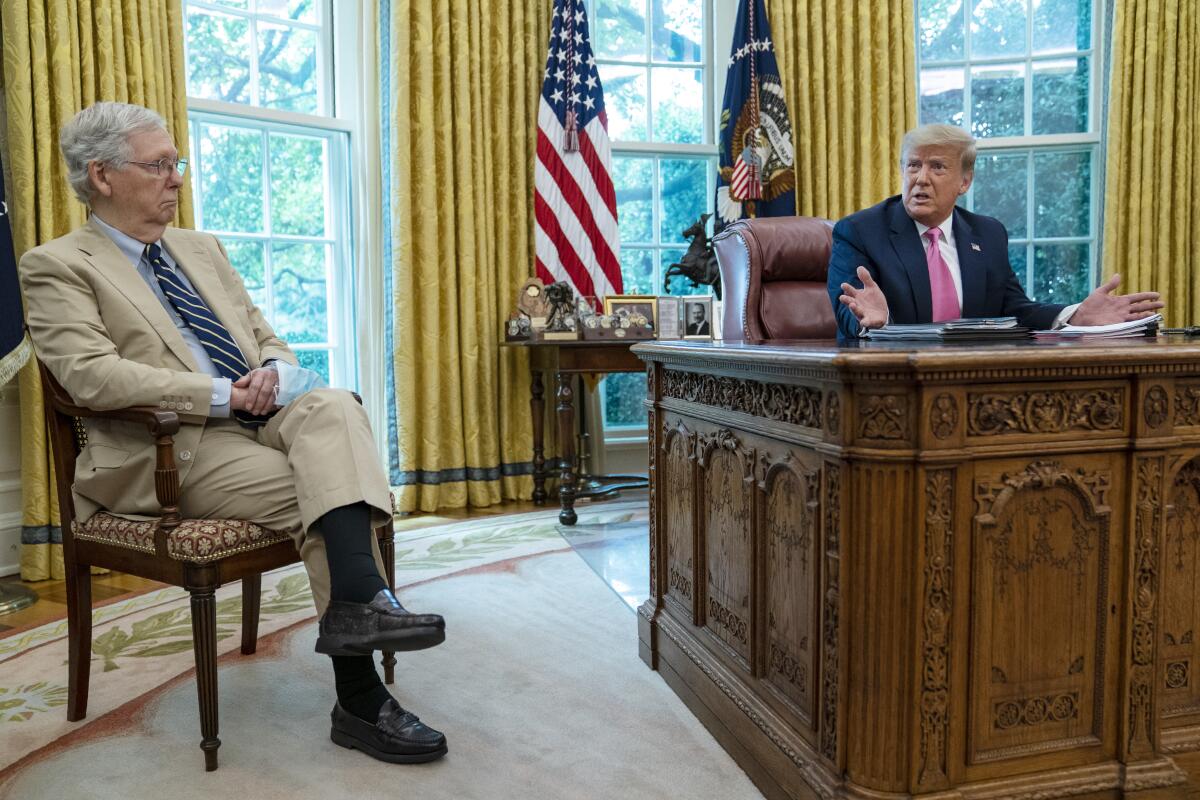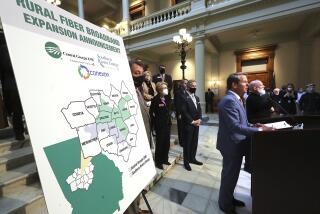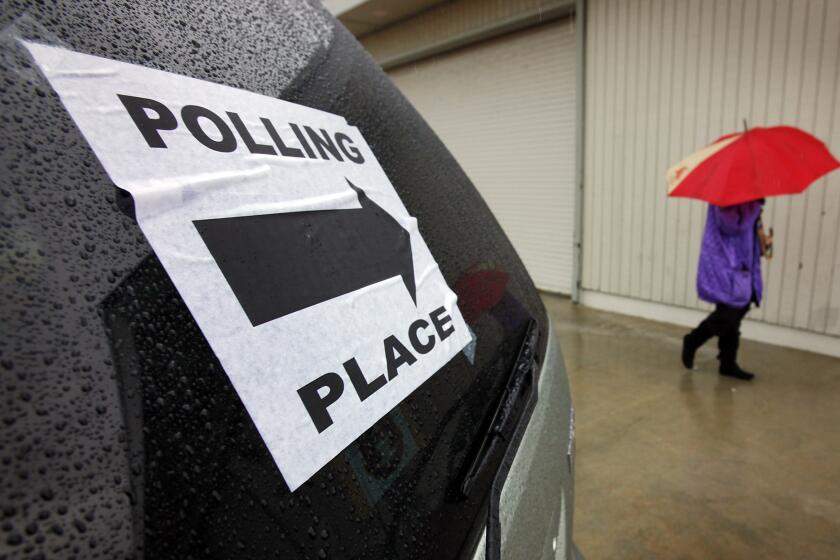GOP coronavirus plan includes another $1,200 check, cuts unemployment benefit to $200

WASHINGTON — Senate Republicans on Monday rolled out the major pieces of a $1-trillion economic relief plan that would provide a second round of $1,200 coronavirus stimulus payments to many American adults and slash enhanced federal unemployment payments from $600 a week to $200.
Senate Republicans have struggled for days to hammer out internal differences in crafting their long-anticipated COVID-19 economic relief plan, which they released Monday afternoon as several separate individual bills.
The release of the plan marked the start of negotiations that will involve House Democrats, who passed their own, more generous relief bill in the House in May that includes $1,200 checks and an extension of the $600 unemployment benefit.
The Republican plan provides a new round of stimulus checks to many adults and $500 per dependent, regardless of age. The full amount would go to people with taxable annual incomes of up to $75,000. It would be gradually phased out for people with taxable income up to $99,000; those above that income level would be ineligible for payments.
Democrats proposed the same income scale, but called for $1,200-per-child payments for up to three children.
On the $600 federal unemployment benefits that many laid-off workers have been relying on for months, Republicans would cut the subsidy to $200 a week through September.
After that, Republicans want states to be ready to set up a system in which the federal subsidy would not exceed 70% of the laid-off worker’s previous salary, with a cap of $500 a week. Republicans and some employers have complained that the flat $600 a week payment provides many low-paid workers with more money than they had received while working, making it harder for companies to lure them back to their old jobs.
“We have produced a tailored and targeted draft that will cut right to the heart of three distinct crises facing our country — getting kids back in school, getting workers back to work and winning the healthcare fight against the virus,” Senate Majority Leader Mitch McConnell (R-Ky.) said Monday.
The GOP plan also includes $100 billion for schools to either reopen or adapt to online instruction; a sequel to the popular Paycheck Protection Program targeting more vulnerable small businesses; and new tax incentives to encourage employers to bring employees back to work. It would also protect businesses from coronavirus-related lawsuits, a provision that McConnell said would be required in any final bipartisan agreement.
Democrats, frustrated with delays in the GOP proposal, demanded that negotiations on an agreement start immediately. House Speaker Nancy Pelosi (D-San Francisco) huddled with White House Chief of Staff Mark Meadows and Treasury Secretary Steven T. Mnuchin shortly after the GOP proposal was released.
Pelosi scoffed at the GOP proposal to reduce unemployment benefits.
“Why are you quibbling over $600, when people need that to buy food, pay the rent and, again, inject demand into the economy by spending that money — inject demand and create jobs?” she said on MSNBC. “When they fire the state and local government employees, they’re going on unemployment insurance. So where is the savings in all of that?”
Republicans had plans to introduce a proposal last week, but hit delays because of fractures within their ranks. President Trump wanted a payroll tax holiday, which many Republicans in the Senate opposed. And generally, many Republicans are skeptical of spending another trillion dollars — or likely much more — on another stimulus plan.
Sen. Lindsey Graham (R-S.C.) on Sunday predicted that half of the Senate Republican majority would oppose a final bipartisan agreement, essentially undercutting McConnell in the negotiations and giving Senate Democrats new leverage since their votes will be critical for passage.
“Half the Republicans are going to vote no to any Phase 4 package,” Graham said on Fox News’ “Sunday Morning Futures.” “That’s just a fact.”
Negotiations are widely expected to stretch into next week or beyond, past the expiration of some current benefits, such as the $600 in unemployment, which expires Friday. In most states, including California, the benefits stopped on July 25 because most state unemployment systems operate on a weekly basis and couldn’t extend the benefit into the final, partial week of July. The House was scheduled to leave Washington at week’s end for its August recess, but Democratic leaders have already said they expect the House will be in session next week.
Republicans argue that reducing the enhanced unemployment payment would encourage people to go back to work.
“We want folks to go back to work and we don’t want to create disincentives to work, so we’re creating a technical formula that will get you 70% of the wage,” White House economic advisor Larry Kudlow told reporters at the White House Monday morning. “It’s a very strong package.”
But state unemployment experts warn that the GOP’s proposed percentage-based system could be complex and time-consuming to set up, particularly at a time when unemployment offices have been under siege by new claimants.
The National Assn. of State Workforce Agencies, which represents governments administering unemployment insurance in all 50 states, said that for most states it would take eight to 20 weeks to program and implement a system in which agencies paid a certain percentage of replacement wages for each individual worker.
In contrast, a proposal to pay a flat add-on amount to all workers would take from one to five weeks. “Maintaining a flat amount without a calculation is the preference of NASWA members. States have experience programming a specific dollar amount for a plus-up,” the association said in a July 23 memo discussing various options that Congress might adopt.
The GOP plan is further complicated by the different ways in which states calculate a worker’s qualified earnings, as well as the wide range of maximum jobless benefits, with Florida paying no more than $275 a week while workers in Massachusetts can get up to $823.
“Even if equitable standards can be developed, the idea of requiring states to run a federal supplement program that calculates a different amount for more than 30 million jobless workers receiving some form of unemployment benefit will layer additional processing time and bureaucracy onto a system that is already crumbling under the weight of unprecedented demand,” said George Wentworth, a 35-year veteran of the Connecticut Labor Department who is doing work for the National Employment Law Project.
The White House tucked one provision into the bill that even Senate Republicans were trying to distance themselves from on Monday evening: $1.75 billion for a new FBI headquarters building in downtown Washington.
When asked about the provision at a news conference, McConnell momentarily suggested he didn’t know it was in the bill, then pointed reporters to the administration.
“They’ll have to answer the question on why they insisted on that provision,” he said.
Times staff writer Don Lee in Washington contributed to this report.
More to Read
Get the L.A. Times Politics newsletter
Deeply reported insights into legislation, politics and policy from Sacramento, Washington and beyond. In your inbox three times per week.
You may occasionally receive promotional content from the Los Angeles Times.











